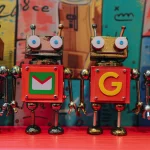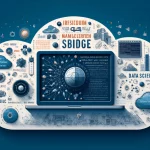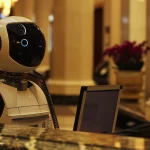AI in the Workplace: Transforming & Improving Processes See how AI in the Workplace can transform the way you work.

Generate AI Voices, Indistinguishable from Humans
Table of Contents
Jane jots down a few notes for her upcoming meeting with the head of procurement, Bob. As soon as she saves them, notes from past meetings with Bob, related reminders she wrote to herself, and pertinent inventory meeting notes appear on the sidebar. None of the notes are tagged. Her AI app organized everything, ensuring she has all the memos she needs for her meeting.
This is how AI in the workplace looks, and it’s happening in thousands of offices worldwide. Enterprises enhance customer experience and reinforce brand identity through AI voice cloning, staffing agencies screen applicants for open roles through people analytics, and manufacturers do labor-intensive work through autonomous intelligent robots.
The IBM Global AI Adoption Index 2022 reveals AI adoption continues to grow. At 35%, it is a four-point increase from the preceding year. Additionally, 42% more of the enterprises surveyed reported they are considering it.
Corporations and venture capitalists are pouring money into AI. Statista says global corporate investment in AI in 2021 was nearly $94 billion, higher than what it was in the previous year.
IBM’s research underscores how organizations use AI to address skills and labor shortages and improve the efficiency and productivity of the current workforce.
Beyond the organizational benefits of increased productivity and efficiency, AI can transform and improve business processes, enhancing customer and employee experiences.
A Brief History of Artificial Intelligence in the Workplace

The statement AI is the future is no longer true. AI is here now, and it’s disrupting every industry. It hasn’t always been this way. The AI the world sees and perceives now is a product of decades of work.
The concept of artificial intelligence has long existed in and excited curious minds. Adrienne Mayor of Stanford University places AI’s inception in ancient Greek literature during the lifetime of the Greek poets Hesiod and Homer. The Greeks’ work referred to Hephaestus creating the giant bronze robot Talos, the artificial woman Pandora, and automated gold servants.
Alan Turing was also fascinated with AI. He proposed that, like humans, machines can solve problems and make decisions using reason and available information. His paper, Computing machinery and intelligence (1950), provided a discourse on building intelligent machines and testing their intelligence (a.k.a., the Turing Test).
Additionally, a Bell Labs researcher, Claude Shannon, built a primitive machine learning system in 1950. It was Theseus, a robot mouse that “learned” and “remembered” its way out of a maze.
The last decade of the 20th century proved to be a pivotal moment in AI. Then, IBM’s Deep Blue program defeated chess grandmaster Gary Kasparov and Windows implemented Dragon Systems’ speech recognition software.
The rest, as they say, is history.
Artificial Intelligence in the Workplace From the 70s-Present
In the workplace, the automation of data-driven tasks began with the material requirements planning (MRP) systems of the 1970s. This continued with the manufacturing resources planning (MRP II) systems of the 1980s and the enterprise resource planning (ERP) systems of the 1990s. The early 21st century saw the rise of sophisticated or intelligent business process management (BPM) suites capable of process modeling and analytics.
However, these systems were limited and still primarily required human intervention. They belonged to the field of automation, rather than artificial intelligence, until the advent of intelligent automation, which, according to IBM, shifted “the burden of processes from humans to technology.”
This shift occurred largely after 2010, fueled by greater computer processing powers. During this time, AlexNet, a deep-learning neural network, was invented. This and other developments paved the way for AI systems with significantly advanced, human-like language and image-recognition capabilities. This, in turn, facilitated intelligent automation in the workplace.
The following components comprise AI-powered or intelligent automation:
- Machine learning – the ability to learn
- Natural language processing (NLP)– the ability to comprehend human speech
- Robotics – the ability to move, act, and decide autonomously
- Predictive analytics – the ability to predict outcomes
AI and related technologies are disrupting and revolutionizing the workplace
Artificial Intelligence in SaaS Industries
AI itself is the “product” or “service” offered by some AI SaaS companies (e.g., Grammarly, EnsoData, and CognitiveScale). Developments in AI naturally have a direct impact on these organizations.
However, AI also affects non-AI-focused SaaS businesses. Microsoft, a provider of SaaS office tools, uses AI to provide “billions of intelligent experiences.” In an earnings call, Chief Executive Officer Satya Nadella said Microsoft plans to incorporate AI in all its products and services.
AI can help SaaS companies accelerate business growth in several ways, including the following:
Customer Relationship
SaaS companies can automate client interactions using AI-powered customer chat software (i.e., chatbot). AI chatbots can take over routine customer interactions, ensuring prompt support and 24/7 responsiveness. This enables customer support personnel to focus on complicated customer issues and concerns.
Additionally, SaaS companies can use AI to develop their knowledge base software or library.
They can create step-by-step instructional videos using text-to-speech software. These videos can do the following:
- Teach clients how to use their products and services.
- Teach clients how to troubleshoot issues on their own.
- Answer their clients’ most frequently asked questions.
- Suggest use-case applications.
- Teach clients how to maximize the benefits of the SaaS tool.
Marketing
AI can enable SaaS companies to automate marketing.
SaaS companies can use machine learning for advanced modeling, creating highly-specific algorithms that provide valuable marketing insights. They can then use these models or algorithms to predict their clients’ behavior.
Predictive analytics helps SaaS companies calibrate their marketing strategies so they can be more relevant and persuasive thereby generating more sales leads.
SaaS businesses can utilize marketing automation software to create market segments, personalize marketing campaigns, and enhance targeting. Marketing automation can help companies orchestrate the client journey and, through personalized marketing messages, notifications, and recommendations, engage clients and guide them into making decisions.
Additionally, SaaS companies can create text, audio, and video content for inbound marketing using AI text-to-speech software. They can create and distribute podcasts and videos designed to engage, attract, and educate their target audience using AI text-to-speech voices. It can also enable localization efforts if it offers text-to-speech conversion in different languages.
Meanwhile, AI-powered copywriting software can help SaaS businesses create different types of content. Tools like Jasper can write web, sales, and landing pages, articles for search engine optimization and link-building, and copy for search and social media adverts.
Branding
SaaS businesses can use an advanced AI voice editor to create a custom AI voice that clients will associate with their brand. They can even use AI voice cloning to generate an official brand “voice” from a real person’s voice — i.e., the CEO’s. AI image generation software can help SaaS businesses create their branding assets (e.g., logos) and the images to use in marketing campaigns.
Product Development and Improvement
AI makes data-driven product development possible. Using client data trends and patterns revealed by machine learning, SaaS businesses can develop features and value-added services to increase client loyalty and satisfaction. They can speed up feature development and rollout through AI-driven programming workflow automation and prototyping programs that can write, debug, test, and optimize software development projects.
AI can help resurface recommendations, keep track of employee hours & open issues, and automatically notify team members on a need-to-know basis.. It can provide clients with a no-code tool to customize the SaaS solution according to their needs and preferences, significantly enhancing customer experience.
Infrastructure Stability and Cybersecurity
SaaS companies can automate cloud operations using AI cloud monitoring and management software. This can monitor, manage, optimize, and self-heal cloud components without human interference or input, ensuring optimal uptimes and minimal downtimes.
Machine learning can also recognize threat patterns, helping SaaS companies automate risk detection and security hardening to block security threats.
Artificial Intelligence in Traditional Industries
AI has general applications traditional businesses (a.k.a. non-SaaS companies) will find particularly useful.
Manufacturing
Equip robotic arms with artificial intelligence, and one gets workers who have autonomous decision-making capabilities.
Autonomous-guided vehicles or smart robots can replace human-operated forklifts and carts. They perform the repetitive tasks of moving parts, equipment, raw materials, and work-in-process goods around shop floors and warehouses, guided by continuous communication with a computer, either through machine-to-machine (M2M) or Internet of Things (IoT) systems using MQTT protocol
Banking and Finance
Banks and financial institutions have stringent regulatory responsibilities. To protect themselves and ensure regulatory compliance, they require specific information and many documents from their customers.
AI-powered data extraction software can extract, verify, validate, and collate customer information from client-submitted documents and other data sources. AI programs can also tag red flags, identify risks, and perform hand-overs to bank personnel whenever necessary for human intervention.
Insurance
Big data and conversational ai can help insurance companies make premium pricing decisions. In the past, insurance companies set premium prices based on a fixed schedule. Now, with the help of artificial intelligence (particularly machine learning and big data analytics), insurance companies can use dynamic pricing to minimize their risks and maximize their gains.
Insurance companies can use intelligent document extraction programs to speed up client information intake and verification, shortening insurance application processing turnaround times. Meanwhile, AI-powered expert systems can automate or simplify decision-making for insurance company employees, ensuring that someone with less specialized knowledge can make underwriting decisions.
Insurance companies can also use AI fraud detection software to identify and prevent fraudulent claims.
Retail
Intelligent inventory software, including intelligent enterprise resource planning systems with inventory management functions, can help retail companies prevent stockout losses. These systems use historical inventory and sales data to automate production order creation. They can even automate procurement for retailers that rely on third-party suppliers for their merchandise. With their help, retailers will always have sufficient inventory at every branch.
Intelligent inventory systems can be linked to multiple in-store and online sales channels. This ensures the program gets real-time sales data on which to base its inventory decisions and can automatically remove items from online storefronts when they become unavailable. Doing this prevents overselling and the dissatisfaction that might arise from customers ordering out-of-stock items.
Retailers can also use natural language processing models to perform sentiment analysis. This entails sifting through the references people have made to their brands in various channels (e.g., emails, chat support, social media, and review sites). By analyzing the words people use and how they said them, AI programs can gauge how people, particularly the retailers’ target market and existing customers, feel about a retailer’s products and brand.
Oil and Gas
Training an AI system on an oil and gas company’s decades worth of sensor data can help it develop predictive algorithms capable of predicting equipment failure. This can help upstream companies shift from a preventive maintenance framework to a more efficient predictive maintenance schedule.
At Shell’s Perdido Platform, the subsea pumps would malfunction without warning and stop separating oil and gas mixtures. The contamination meant lost production. Unfortunately, Shell could not inspect the pumps manually, as they lay 8,000 feet underwater.
Shell turned to AI. An AI team fed years of sensor data from the pumps to an AI system. Modeling learning algorithms revealed a pattern: In 70% of the incidents, a chemical signature was evident a few days before the pump malfunction. This became the basis for the platform’s subsea pump predictive maintenance schedule, saving the company time and money by preventing production losses.
Note: Predictive maintenance does not only apply to oil and gas companies. Other enterprises that use any equipment (e.g., manufacturing, construction, and logistics) can use AI for the same purpose.
Transportation and Logistics
AI can speed up loading, unloading, and sorting at warehouses. AI-driven autonomous guided vehicles can bring parcels and pallets to appropriate containers and loading stations, minimizing shipping errors.
AI software can design streamlined and automated transport and logistics workflows. This can help transport and logistics companies become more efficient and productive.
Predictive analytics also yields accurate demand forecasting, allowing transportation and logistics companies to match their capacity to demand. Consequently, they will not run more vehicles or purchase more cargo space from ships and airplanes than demand requires.
Smart route planning programs can help transport, and logistics companies adjust their travel and shipping routes to minimize costs and delays and maximize profits. AI can also power client and customer support software that can chat with clients and customers and automatically notify them about their cargo or parcel status.
Examples of Artificial Intelligence in the Workplace: Tools for the Workplace
There are many AI-powered, AI-enhanced, or AI-driven tools for the workplace. The following are just some AI marketing, sales, and recruitment tools.
Marketing
Companies can automate marketing processes and functions using the following AI tools.
Play.ht

Play.ht is an online text-to-speech tool with over 900 AI text-to-speech voices in more than 130 languages and a powerful text-to-speech editor that allows one to set gender, AI voice style, rate, pitch, volume, and emphasis for the ultimate AI voice customization control.
Enterprises can use Play.ht’s ultra-realistic AI voices to create voiceovers for television, radio, and social media ads, create a representative voice for their help desk and knowledge-based videos, and generate localized ads.
SurferSEO
SurferSEO is an AI-assisted suite of search engine optimization (SEO) tools. Grow Flow automatically provides personalized SEO recommendations and action items based on Google Search Console data.
Content Editor offers keyword and optimization suggestions for SEO articles and content. Keyword Surfer provides keyword search data on the fly, and the Article Outline Generator does what its name indicates: generate article outlines.
Ortto
Ortto’s marketing AI tool can generate royalty-free images for use in marketing campaigns, predict email open rates based on the email subject line, suggest optimal open-rate subject lines, clean up email lists to remove broken records, resolve data mismatches, and create email around a bulleted list of marketing messages.
Copy.ai
This tool lets businesses create sales copy, outreach emails, product descriptions, and long-form content for inbound marketing. Copy.ai can also repurpose and optimize existing content so it can be used on a different channel.
Personalize.ai
Using data from customer interactions, loyalty rewards, location intelligence, marketing campaigns, point-of-sales, and digital activities, Personalize.ai gives customers personalized recommendations on marketing channels.
This improves engagement and relevance and, ultimately, drives up sales and customer lifetime value. It also provides actionable data on customer feedback and behavior.
Sales
The AI tools below can help organizations equip sales teams, streamline revenue-generating activities, nurture leads, and increase sales.
Exceed.ai
This conversational, multi-channel AI tool captures and engages leads, automating conversations to move leads through the sales funnel. It can even qualify leads and automatically schedule sales meetings.
Crayon.co
Crayon.co is an intelligence platform that gathers information from millions of sources, uses machine learning to capture crucial intelligence, and distributes insights to business teams, especially strategic leadership and sales teams. It allows organizations to leverage large-scale data and intelligence to inform and improve revenue-generation activities and workflows.
Solutions.AI for Pricing by Accenture
Accenture’s AI-driven tool uses machine learning to provide pricing support to business organizations. It offers real-time, personalized, and dynamic pricing recommendations based on individual customer preferences and big data. It helps companies optimize pricing to maximize revenue and minimize profit leakage.
SetSail.co
SetSail collects data from sales activities. Subsequently, it highlights those that lead to a faster closing. The insight it provides lets businesses institutionalize and operationalize sales activities that can accelerate sales and growth.
Clari
Clari is a revenue optimization platform designed to help sales teams increase win rates, reduce failed deals, and improve productivity. It captures, records, and syncs data, minimizing errors and saving sales teams time.
Clari summarizes calls and provides personalized recommendations on sales representatives’ next steps to improve their chances of closing deals. The platform also offers easy-to-digest information for sales teams to manage their pipelines, spot risks, and project outcomes.
Recruitment
Even before the widespread use of AI in the workplace, staffing companies and human resource departments have been using big data and HRIS software to streamline recruitment processes. For instance, Unilever has been using AI in recruitment since 2016. The following are AI recruitment tools organizations can use to shorten time-to-hire and improve recruitment success rates.
Fetcher.ai
This tool finds potential candidates online, gathers data across the web, and aggregates collected data into easily viewable candidate profiles.
The ICIMS Talent Cloud AI
This talent cloud AI gives candidate recommendations, including candidates who might not have applied for the position. It categorizes candidates according to skills and experience and explains the resulting recommendations.
Arya by Leoforce
Enterprises can integrate Arya by Leoforce into their applicant tracking systems. It screens for qualified candidates and makes recommendations based on predicted success rates. It even helps with job ad placement and candidate engagement.
Oracle Recruiting
Oracle Recruiting can guide talent acquisition teams on which skills to include in job descriptions, provide time-to-hire estimates, and make best-fit candidate recommendations. It can find candidates with similar qualifications and recommend open roles suitable for candidates in the pipeline.
Skillate
This decision-making engine helps companies attract qualified talent by assisting them in writing compelling job descriptions. Skillate also parses resumes to extract information, matches resumes to job requirements, and uses an AI chatbot to engage candidates.
AI in the Workplace: Improving Efficiency, Productivity, and Experiences
AI has come a long way from the robotic mouse that can memorize its way out of a maze. Businesses that work with and use AI in the workplace can attest to how it can transform workflows, improve business processes, yield efficiency and productivity gains, and enhance customer and employee experiences.
Play.ht is an AI-powered text-to-speech tool that lets you quickly, easily, and cost-efficiently add ultra-realistic AI voice to ads, presentations, marketing videos, and customer support content.





 Conversational
Conversational
 clone your voice
clone your voice

















































